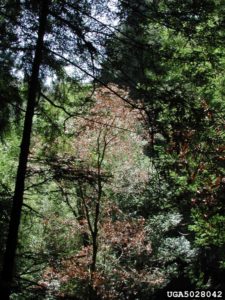oak tree infected by P. ramorum; photo by Bruce Moltzan, USDA Forest Service
Sudden oak death (caused by the pathogen Phytophthora ramorum) might seem to be an old story – after all, mortality of oaks and other trees in the San Francisco Bay area was first noted 20 years ago. See the information here or here or my earlier blogs at http://nivemnic.us/2016/04/; http://nivemnic.us/2016/02/; http://nivemnic.us/2015/08/; and http://nivemnic.us/2015/07/
Unfortunately, the story is very much alive – and the situation is getting worse.
In 2016, infected trees were detected in new sites in California. See the November 2016 California Oak Mortality Task Force (COMTF) Newsletter here.
Based on a “SOD Blitz” using surveys by local people, (summarized in the COMTF newsletter), the pathogen has expanded substantially in areas that received adequate moisture in winter/spring 2016.
- For the first time, ramorum was detected in San Luis Obispo County. This is the southern-most county with wildland detections in the state. Nor is it a small single outbreak; the SOD Blitz identified the pathogen on California bay laurel at approximately eight locations throughout the county. The infestations appear to be recent, since oaks were not found to be infected.
- New outbreaks were detected along the central and southern coasts of Mendocino County (north of the San Francisco Bay area).
Infected trees were also detected in areas where the pathogen activity had subsided as a result of the state’s recent drought, including:
- Northern and central Sonoma County and Napa Valley.
- Infection rates have increased in Marin County.
- San Francisco’s Golden Gate Park and the San Francisco Botanical Garden.
- Infection rates in Big Sur in Monterey County increased by 27%.
- There have been sharp increases in infection in some areas that previously were marginally affected, g., western San Mateo and Santa Cruz counties.
In Oregon, the area infested by sudden oak death has been expanding since at least 2014. In 2015, 18 new outbreaks were detected. In 2016, another 65 new outbreaks were found. All are within the state’s quarantine area (which was doubled in size in 2015; it now covers nearly one-third of Curry County). Oregon officials believe this increase is a consequence of the combination of a wet/mild winter and spring and the establishment of the state-designated “Generally Infested Area” (58 square miles) where disease treatment is no longer required.
EU1 strain in forests in Oregon
Oregon has determined that the presence of the EU1 lineage of Phytophthora ramorum is more widespread than originally known. (My blog of August 2015 described the initial finding of a single tanoak infected by this lineage in 2015 and the importance of finding a genetically different form of the pathogen in the wild in North America.) As of late 2016, scientists had identified a second outbreak of the EU1 pathogen – on 1 grand fir seedling and 12 tanoaks. Additional trees might be infected; results were pending for another grand fir and 11 additional tanoaks. This outbreak was detected through follow-up on a stream bait detection. This new EU1 infestation is located between the 2015 EU1-positive tanoak site and a now closed ornamental nursery, which, based on molecular testing, was the probable source of the 2015 EU1 infestation. The new EU1 infestation was top priority for treatment in the fall; these activities have already begun (Information from Sarah Navarro, pathologist for Oregon Department of Forestry).
While sudden oak death has already killed more than 3 million tanoaks reaching from Monterey County north into Oregon, large areas occupied by tanoaks are still not infested. It is important to slow the spread of this pathogen.
The spreading devastation is particularly galling since scientists have shown than an aggressive, well-funded containment effort begun in 2002 could have measurably slowed spread of the disease. See reference and news report below.
References
Cunniffe, N.J., R.C. Cobb, R.K. Meentemeyer, D.M. Rizzo, and C.A. Gilligan. Modeling when, where, and how to manage a forest epidemic, motivated by SOD in Calif. PNAS, May 2016 DOI: 10.1073/pnas.1602153113
We welcome comments that supplement or correct factual information, suggest new approaches, or promote thoughtful consideration. We post comments that disagree with us — but not those we judge to be not civil or inflammatory.
